Italian Renaissance Exam #2
1/57
There's no tags or description
Looks like no tags are added yet.
Name | Mastery | Learn | Test | Matching | Spaced |
|---|
No study sessions yet.
58 Terms
Portrait of Ginevra de' Benci (Leonardo da Vinci)
Sfumato, atmospheric perspective
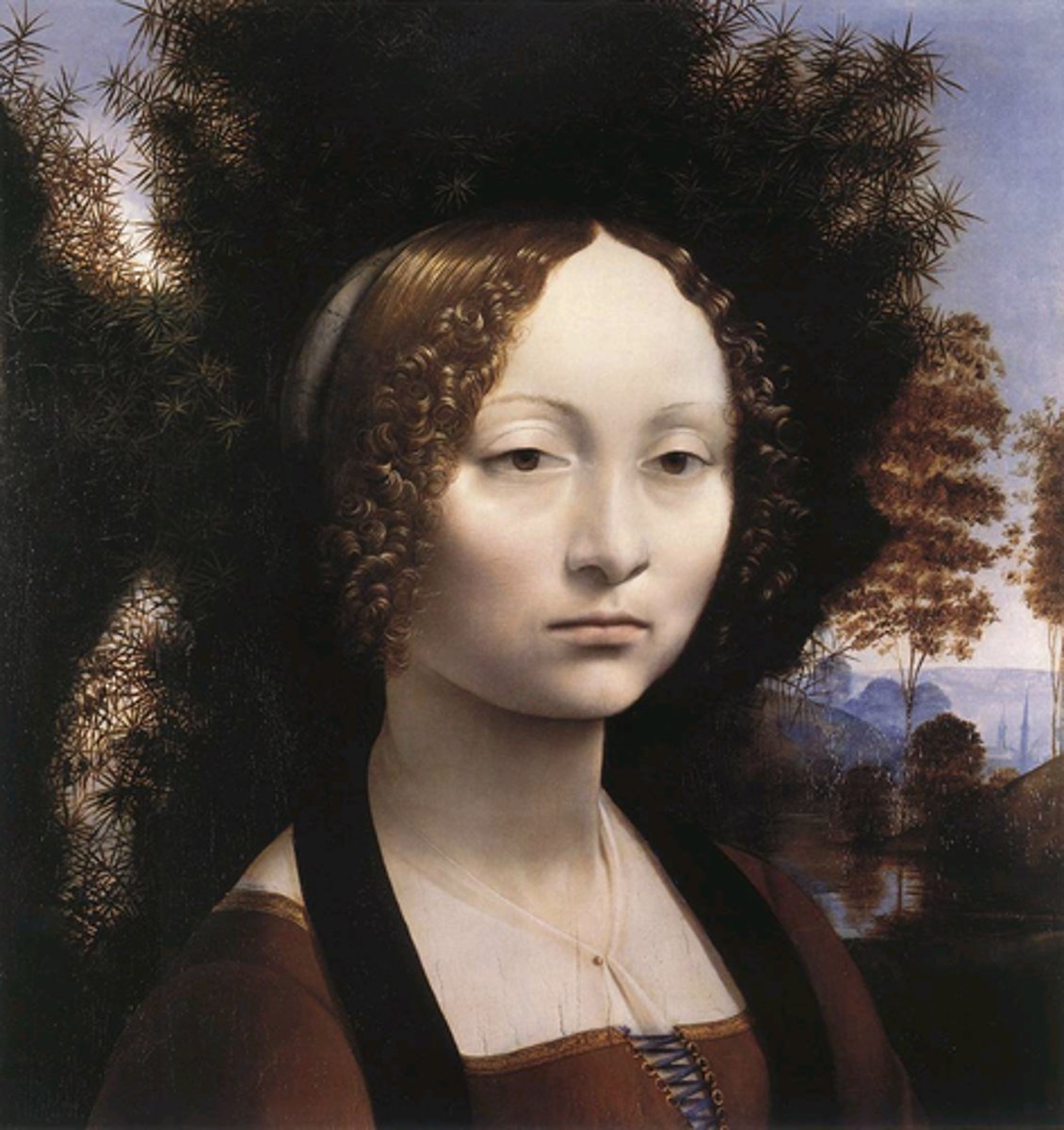
Last Supper (Leonardo da Vinci)
Leonardo da Vinci, The Last Supper, 1498, mixed technique, Convent of Santa Maria delle Grazie, Milan. This was painted while he was at a convent in Milan. We can see his interest in shadow, landscape detail, and orderly characters. Human expressions and shadowed facial features. The folds of the table cloth are visible. Very atmospheric. This painting also fell apart because of his experimentation.
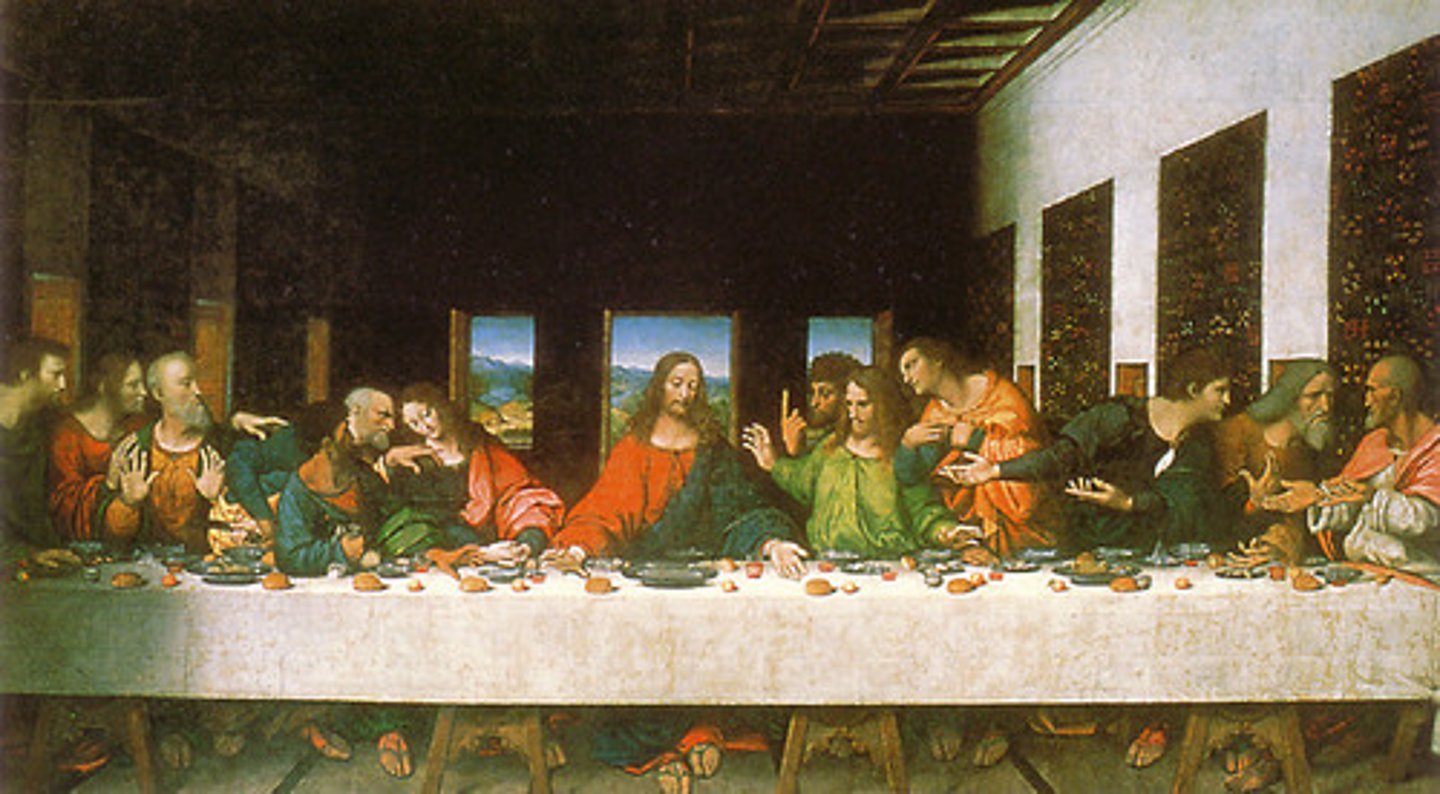
Mona Lisa (Leonardo da Vinci)
The sitter is facing forwards, which is now the norm
The landscape has taken over in atmospheric detail
Muted pallet
Glowy texture of the skin
The shaded neck
The detailed fabric
Leondardo never gave this to the patron and he died with it in his collection
Raises the questions:
Was he going to keep working on it?
Did he love it so much?
Was it special to him in some way?
This was common for Leonardo to not finish a work and give it to the patron
This probably has a darkened varnish to make it more sfumato
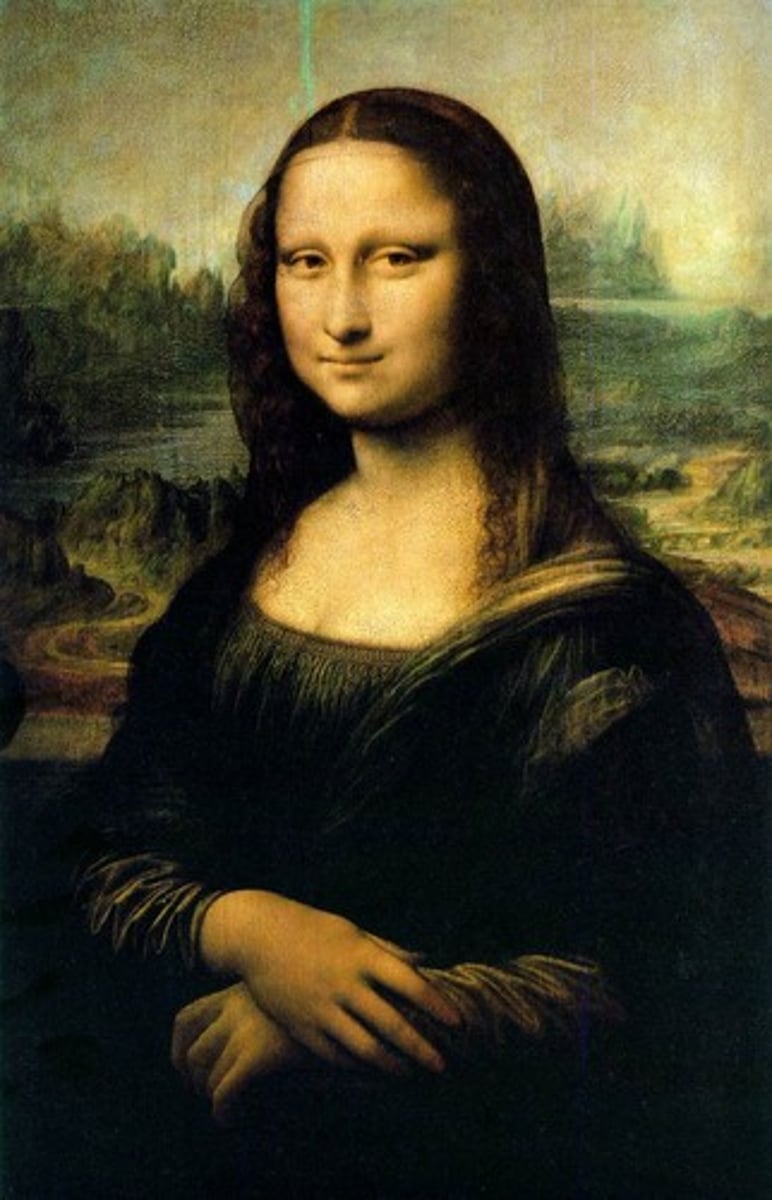
Adoration of the Magi (Leonardo da Vinci) *unfinished
Unfinished, this was supposed to be part of a big panel
Figures ar very shadowy and blended together, like our eyes can't always tell people clearly apart in a distant crowd
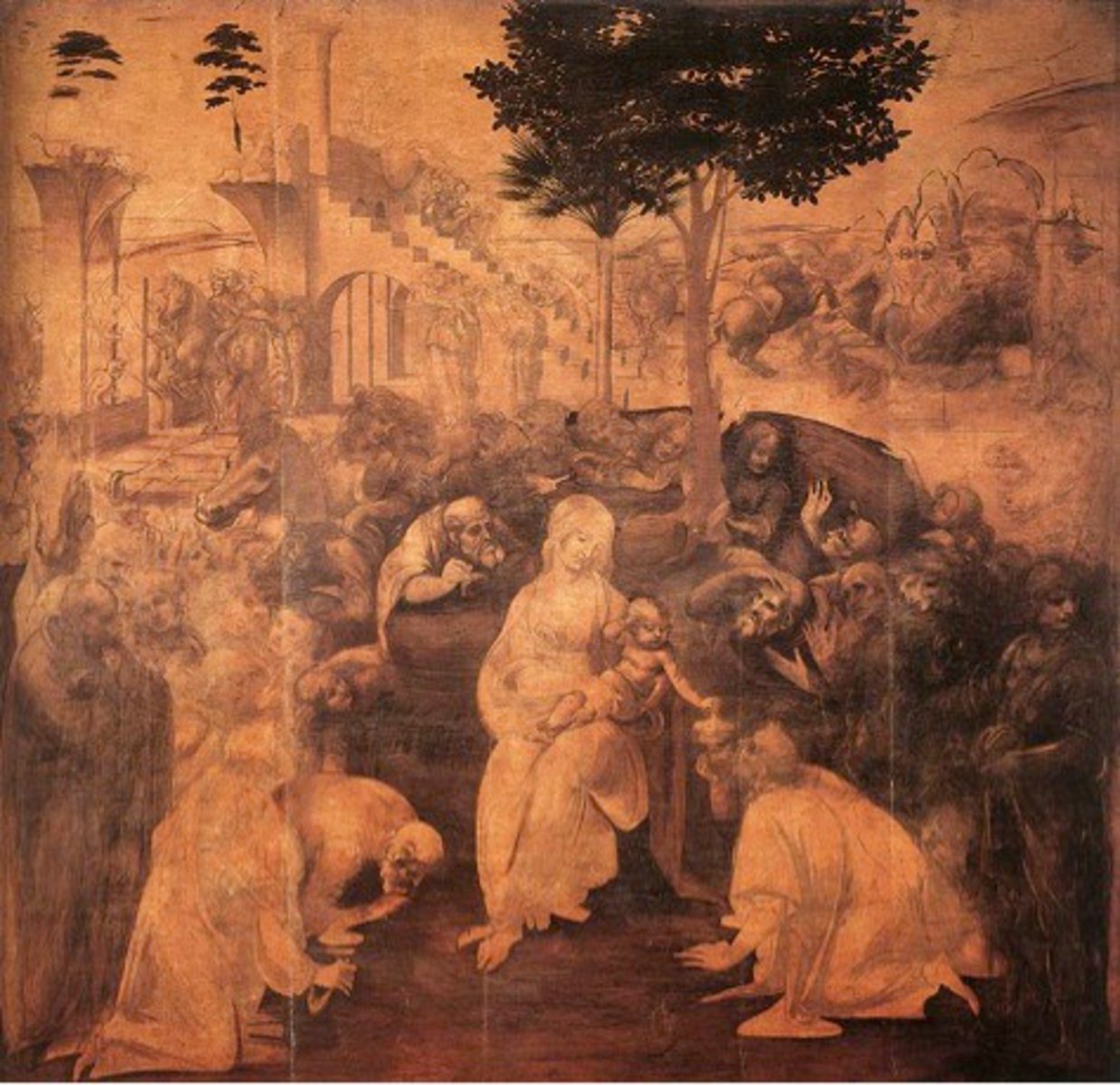
Virgin of the Rocks (Leonardo da Vinci)
Made while he was in Milan
Mist, leaves, human expressions are soft and shadowed, the biological specificity is paramount here, you get the sense of how light is falling
Key words: naturalism, sfumato (shaded/blurred/smoky), atmospheric perspective (the idea that air, water, and atmospheric particles obstruct how the human eyes see something far away)
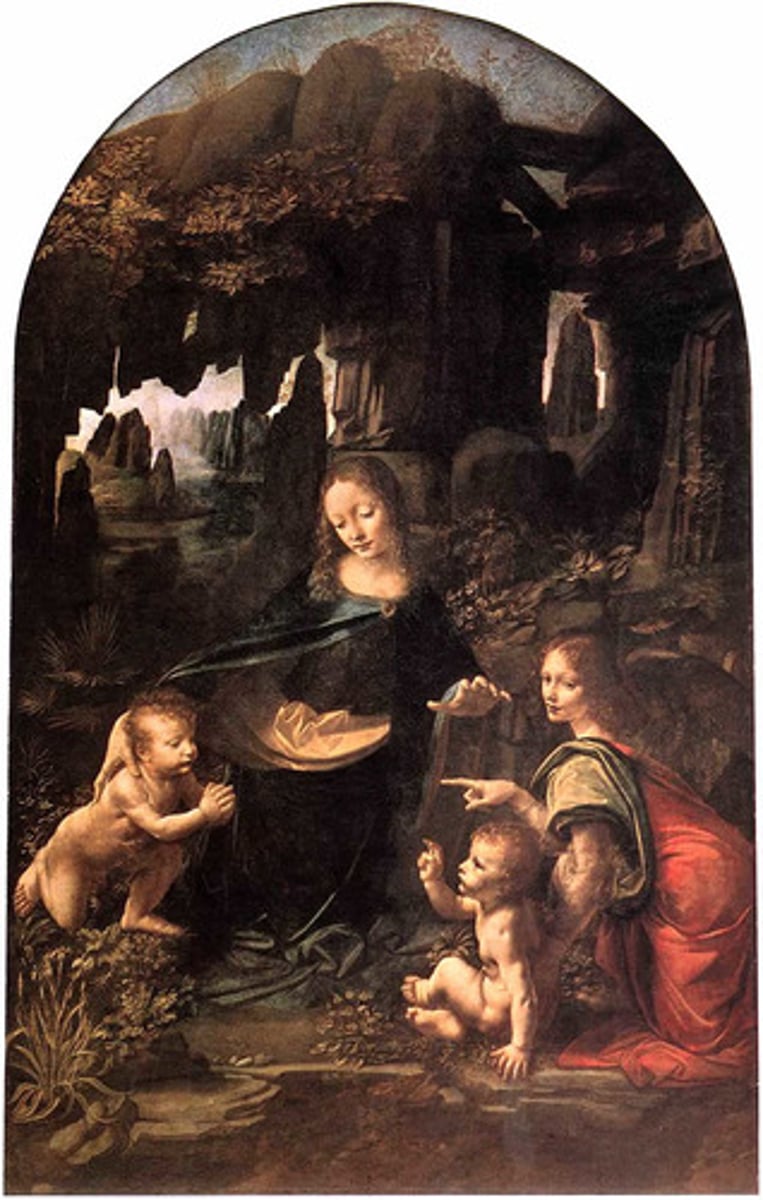
Battle of Anghiari (Leonardo da Vinci) *lost
Hall in Palazzo dei Priori (Palazzo Vecchio), Florence
The town hall/civic center of republican florence
They wanted two frescoes of battles to be depicted where Florence was the victor
They hire Leonardo and Michelangelo
Leonardo da Vinci, Battle of Anghiari, c. 1504-1505 (destroyed)
The horse kicks of dust and creates atmospheric perspective
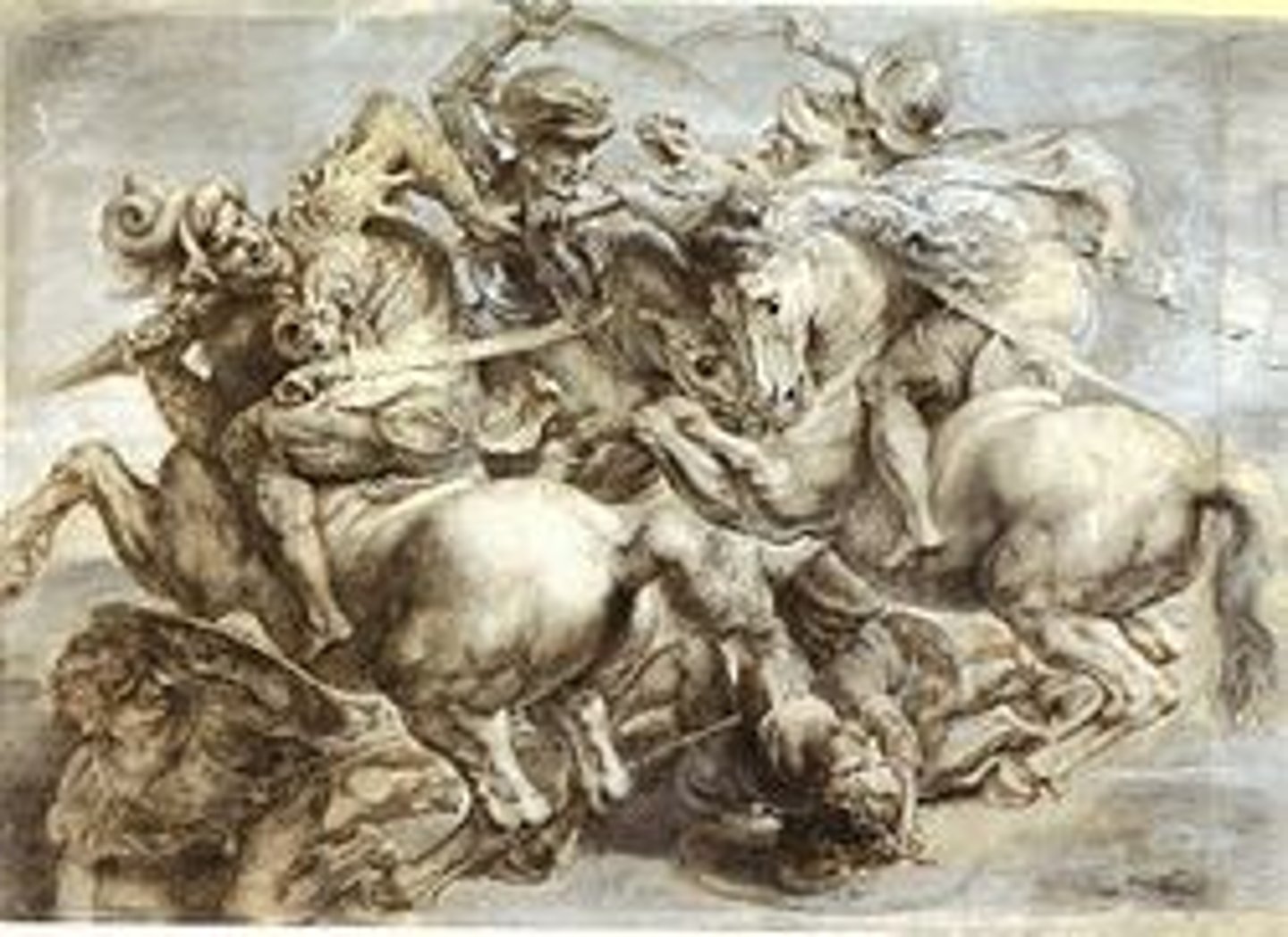
Sleeping Cupid (Michelangelo) *lost
Michelangelo made a cupid sculpture and rubbed dirt and feces all over it and sold it for a lot of money by saying it was an ancient piece
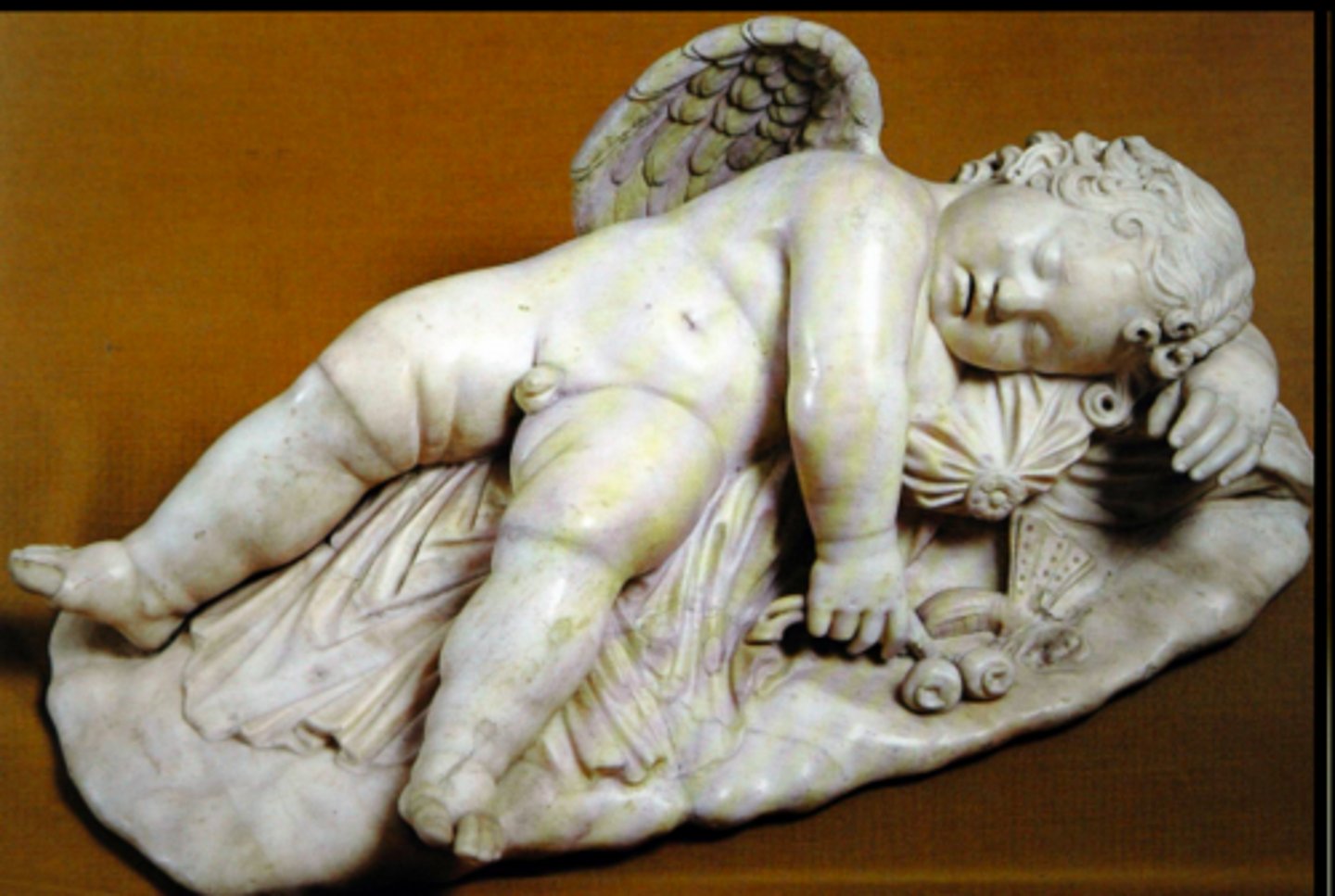
David (Michelangelo)
Carrara marble, Michelangelo gets called back to Florence to make David
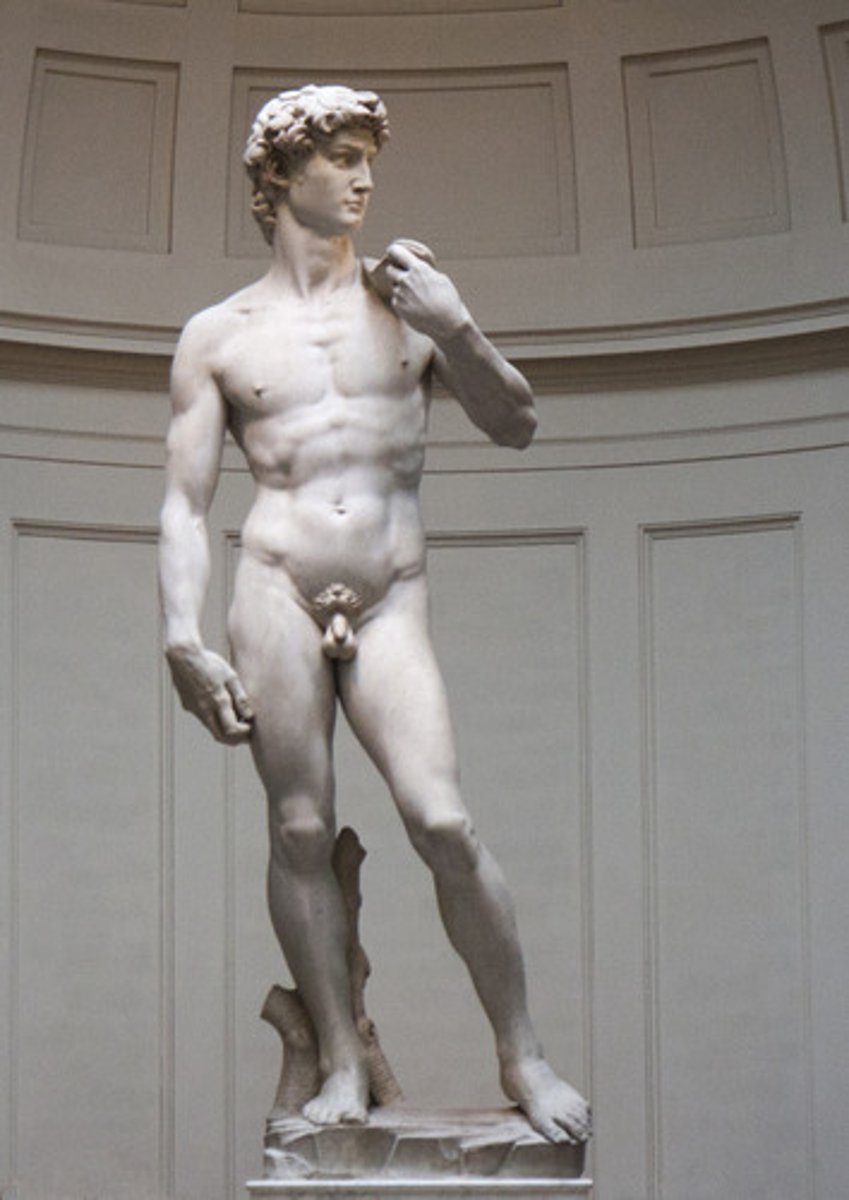
Doni Tondo (Michelangelo)
Michelangelo, Doni Tondo (or Holy Family), c. 1505, tempera and oil on wood
Circular painting
Made before the sistine chapel
A bunch of random ignudi in the background
The themes in this painting are clearly used in the sistine chapel like the nude bodies and positioning of main characters
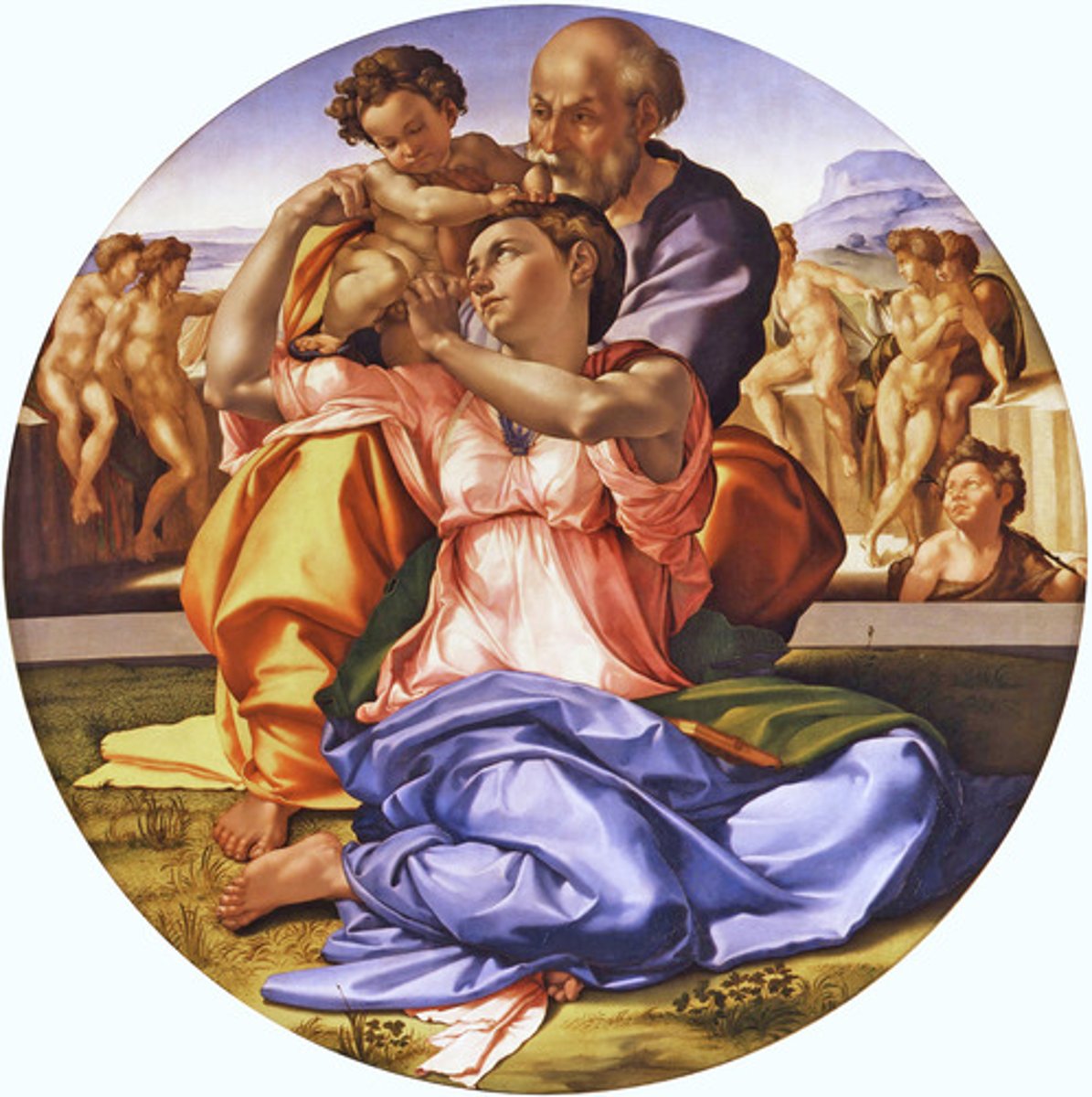
Pieta (Michelangelo)
Michelangelo, Pieta, 1499
Shoots to fame from this piece because nothing like this had been done before
The virgin mary is holding dead christ
Perfected and idealized antiquity
Anatomical precision and drapery
Puts his signature front and center
It's realistic but its idealized realism
The virgin mary is huge in order to hold the weight of christ
Christ is more perfect than he should be
Mary's face is younger than it should be
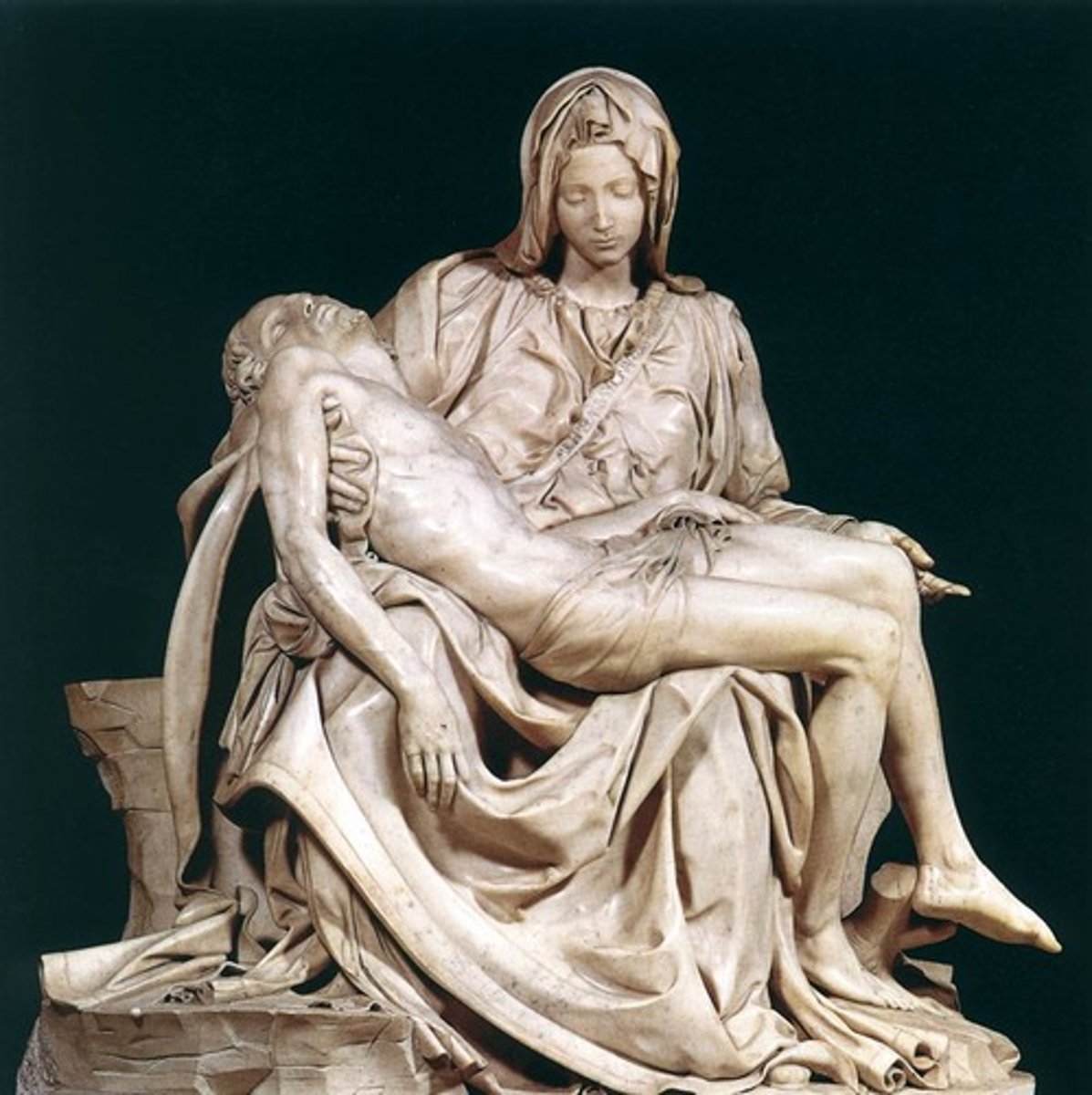
Sistine Ceiling (Michelangelo)
He's really not a painter, there are only two other paintings by him. Fresco painting:
Extremely difficult and quick moving. They were use "cartoons" or sketches to trace the design.
Giornata: "Day" or "days work".
We use this term for each small section of wet plaster that you're working with. Because it dries so fast, you have to work small and quick. When you're up close, you can see the lines of the plaster drying on separate days, so art historians can look at the fresco and know how many days it took Michelangelo to paint the piece. Michelangelo doesn't employ anyone to help him (or so he says). He probably had assistants to grind pigments but perhaps he did paint everything himself.
Sistine Chapel restorations, 1980s
It is possible to do dry touch ups on frescoes, but it was looked down upon by humanists: Fresco secco. Michelangelo says he never did dry touch ups but he did. When the restoration began, they took off these dry touch ups because they thought they were done by someone else (even though we now know that Michelangelo did them).
Michelangelo says he designed the whole layout himself, but that is highly unlikely and he probably had help from historians. He paints fake columns and other architectural details to frame the scenes on the ceiling. Uses very iridescent and bold colors (compare to the muted colors of da Vinci). Prophet Jonah:
Great example of foreshortening and perspective. Lots of random nudes! Ignudi (or singular, ignudo): unnamed nude figures.
Their purpose is only to show the beauty of the human form and how it can move and be portrayed.
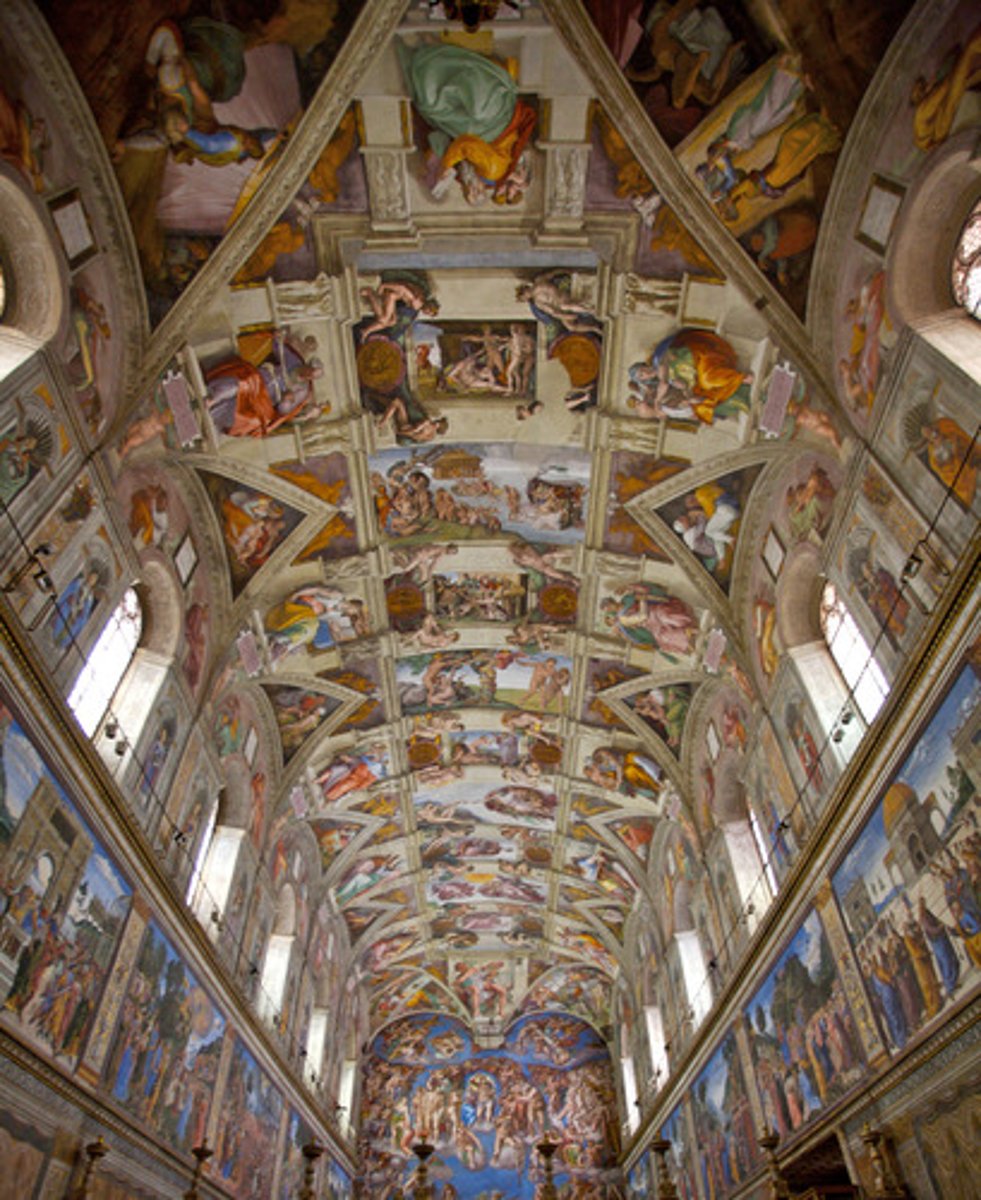
Battle of Cascina (Michelangelo) *unfinished and lost
This is a bunch of naked men taking a bath during battle
He found the only scene in which a bunch of men would be naked together during a war
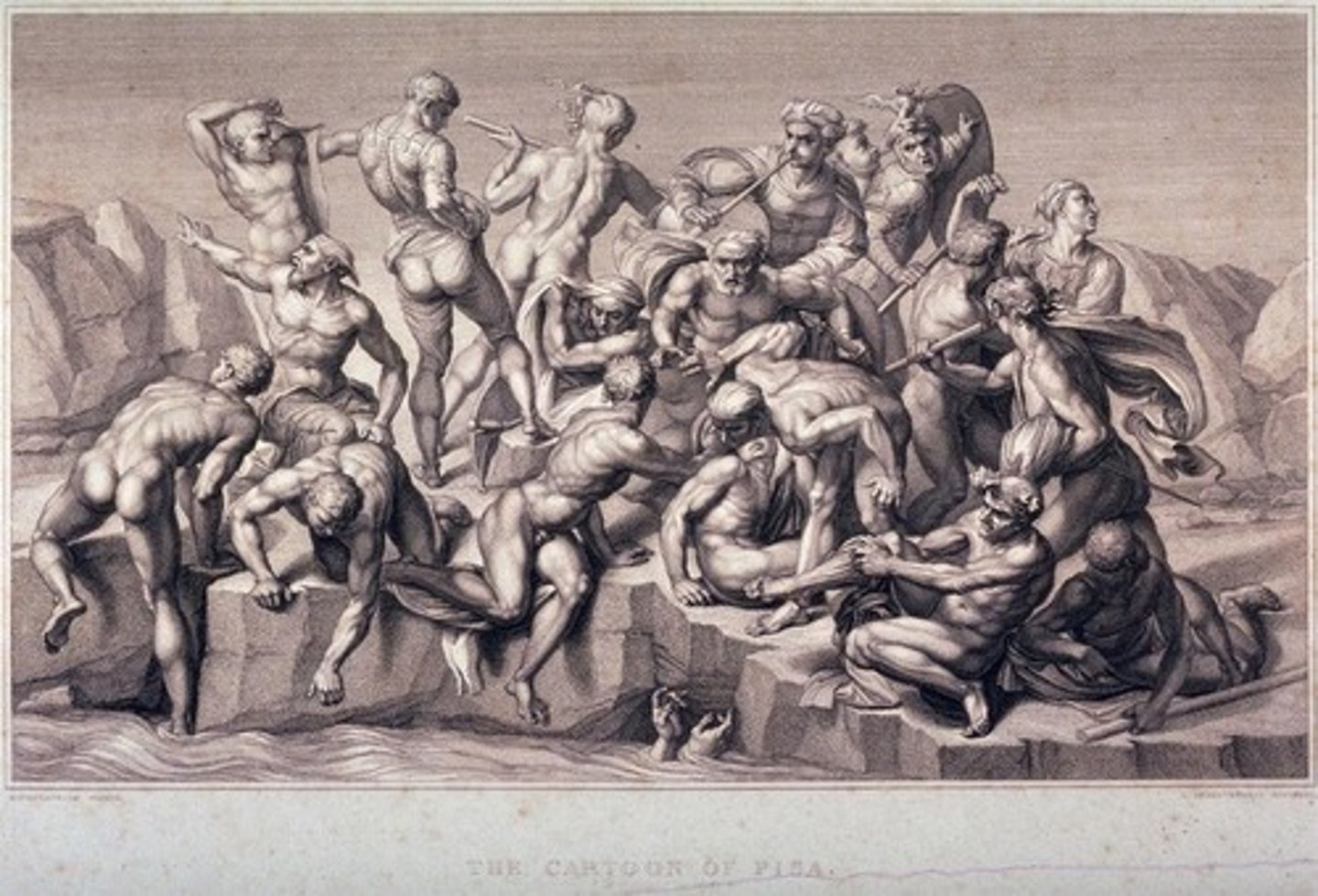
Marriage of the Virgin (Raphael)
Raphael comes from Urbino, the ruling family was the Monefeltros
He came up in a courtly world, unlike Michelangelo
Raphael apprentices with Perugino
Perugino, Giving of the Keys to St. Peter, c. 1481-82, fresco, Sistine Chapel
Crazy orthogonals
Istoria
Characters going every which way
Compare with Raphael, Marriage of the Virgin, 1504, oil on panel
Vasari does not like Perugino and says he's too derivative
Raphael really takes Perugino's style, almost exactly but also surpassing him in talent
Raphael is better at shading and elegance and color
He hides his signature in the building
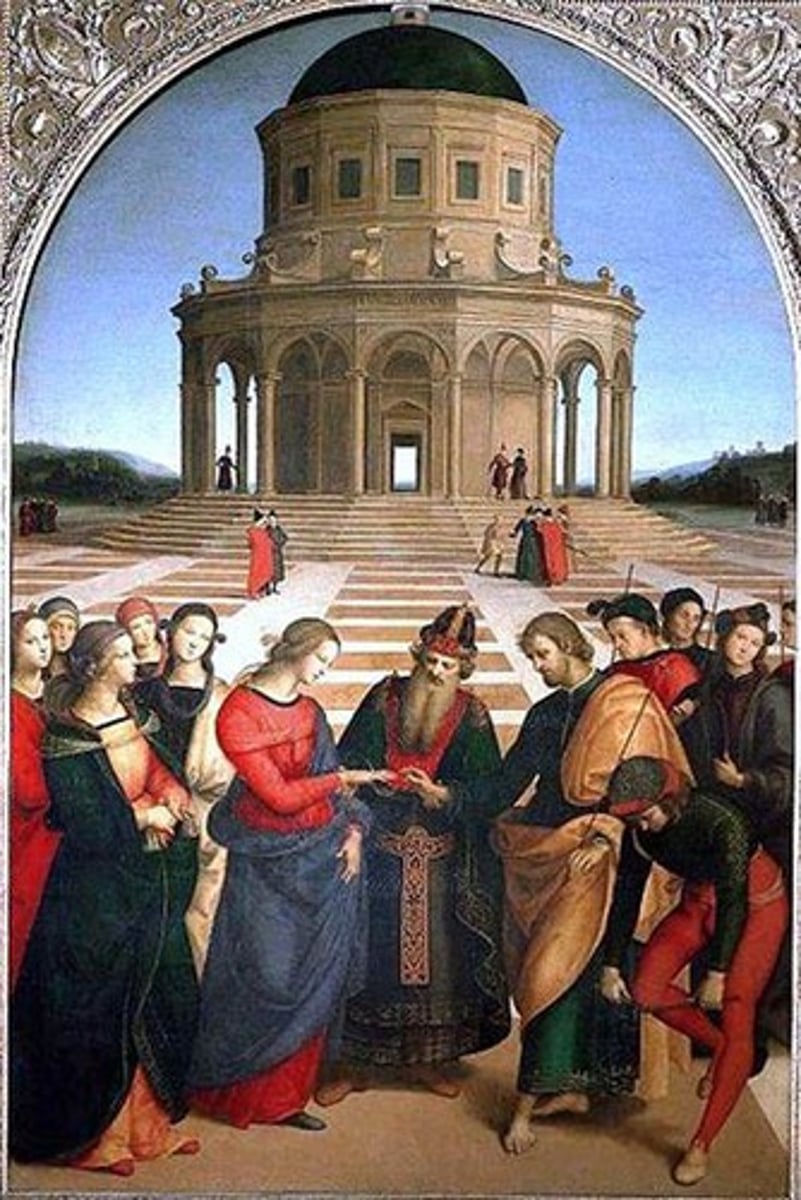
Portrait of Maddalena Strozzi Doni (Raphael)
Raphael, Portrait of Maddalena Strozzi Doni, 1505-06, oil on panel
Glowy colors due to oil paint
Fully front facing female
Receding landscape
Very much competing with Leonardo
Raphael must have seen Mona Lisa because this is so similar
Copying in order to compete mentality
Jewel toned and idealized
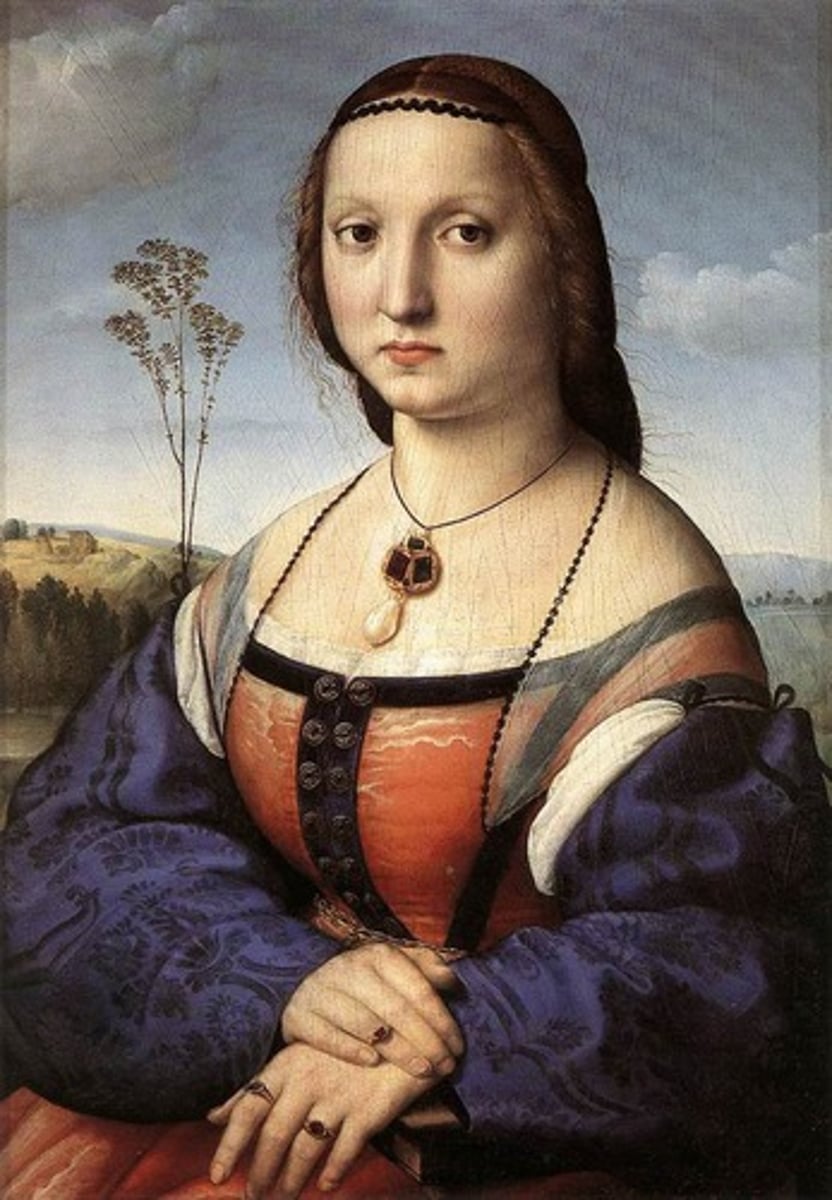
School of Athens (Raphael)
Raphael, School of Athens, fresco, 1509-11
Philosophy
Really really humanist
Romanizing architecture
Orthogonals
One-point perspective
Istoria, beautifully composed in groups
Plato and Aristotle
Plato gesturing upwards signifying this theory of abstraction
He is in purple (air) and red (fire) both of which don't have any weight and lend to the loftiness
Aristotle is gesturing to the ground to signify his observations of the natural world
He is in blue (water) and green (earth) to further ground him
This painting is full of comparisons. Also includes a self portrait of Raphael and Michelangelo. The "Michelangelo" philosopher was added after the fact and painted in Michelangelo's style.
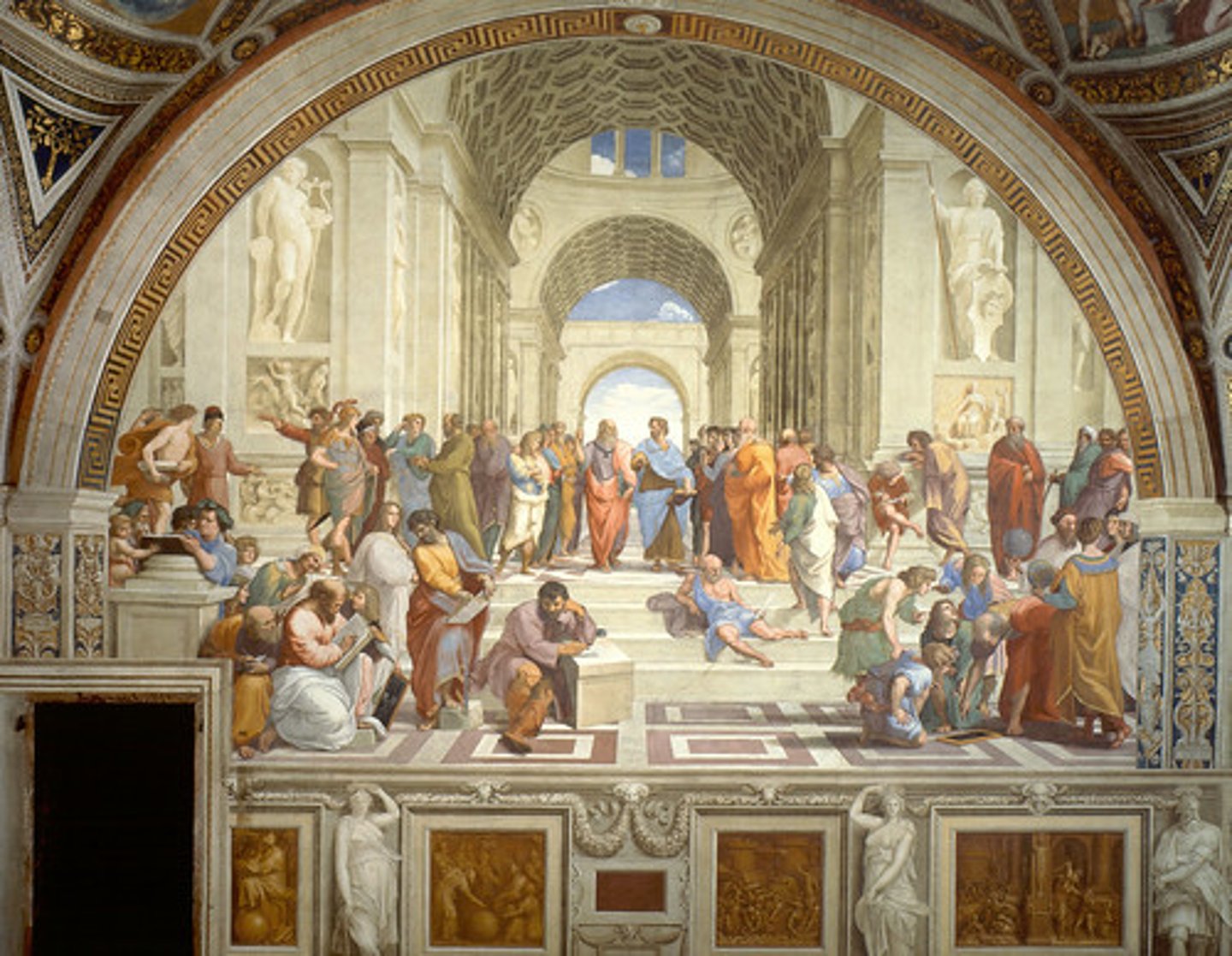
Madonna del Prato (Raphael)
Raphael, Madonna del Prato, c. 1505, oil on panel
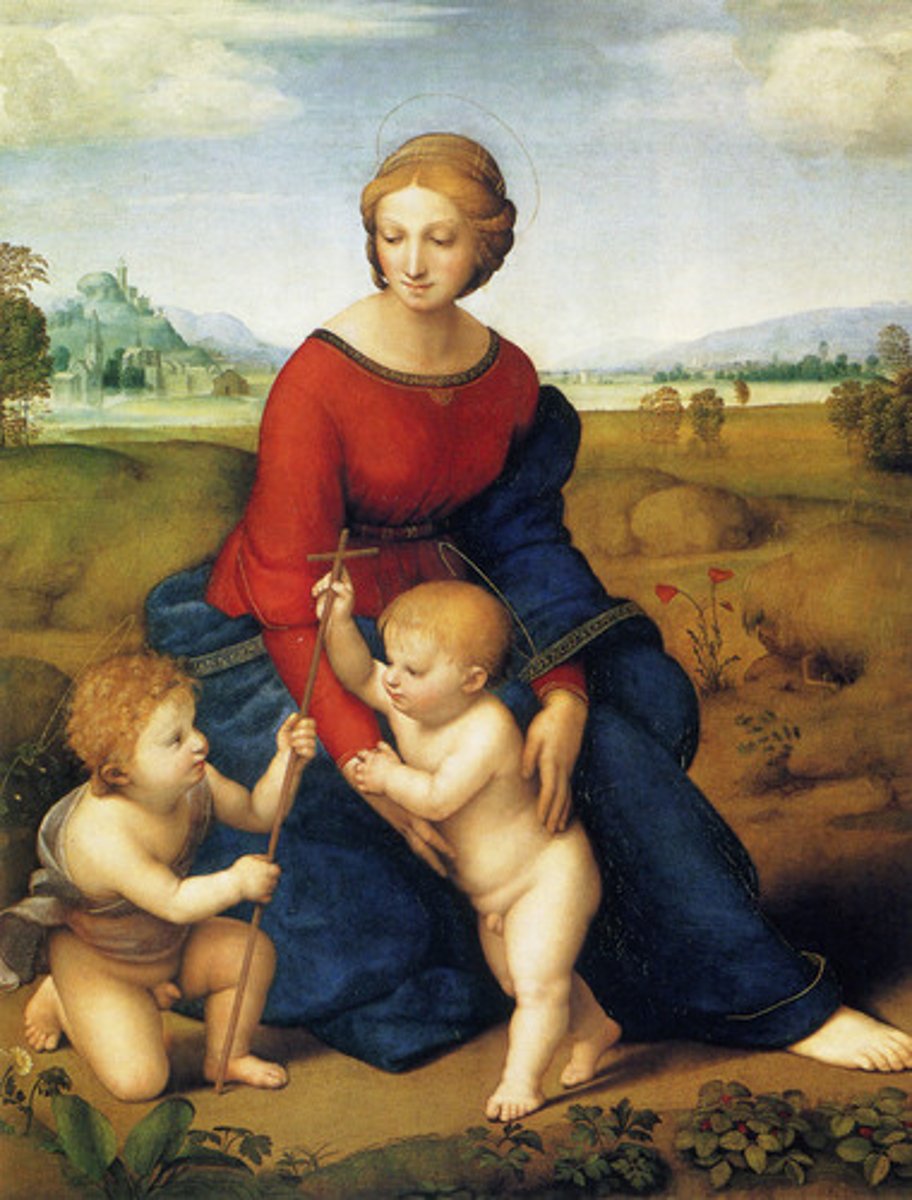
Judgement of Paris (Raimondi) *engraving
Raphael works with Raimondi to create works and prints

Properzia de' Rossi
Vasari's Life of Properzia de'Rossi
The only women who gets a designed chapter in Vasari (although he also mentions Sofonisba)
Joan Kelly's "Did Women have a Renaissance?"
Joan Kelly, 1972
Literary historian, not art historian
"Yet precisely these developments affected women adversely, so much, so that there was no "renaissance" for women, at least not during the Renaissance."
"Women as a group, especially among the classes that dominated Italian urban elite, experienced a contraction of social and personal options that the men of their classes did not experience as markedly."
Sfumato
Italian for "smoky", technique used to blend details to look more realistic (shaded/blurred/smoky) *Leonardo!!!
Atmospheric perspective
atmospheric perspective (the idea that air, water, and atmospheric particles obstruct how the human eyes see something far away) *Leonardo!!!
Naturalism
Art is a reflection of nature. Leonardo's Observational naturalism:
The flowers painted are actually identifiable
Mist covering the mountains in the background
Tiny tiny details that are immersed in hazy mist (almost impressionistic like- like Monet's brush strokes)
Sforza court of Milan
Ludovico "il Moro" Sforza, Regent (later Duke) of Milan
Castello Sforzesco, Milan
Leondardo gets to come here because he met Ludovico through Lorenzo de Medici
Oil paint
allowed for the blending of colors and longer working time and luminosity
Carrara marble
the type of marble Michelangelo used to emulate the ancient sculptors
Nero's Domus Aurea (Golden House)
an ancient Roman house that was excavated while these artists were in Rome and this influenced their replications of ancient architecture. shortly after Nero died (people weren't a fan of him) they filled in his palace and continued to build on top of it. Before this was discovered, nobody exactly new what ancient Roman painting looked like, but now they do and they use the style in the new ceiling paints they create.
Pope Julius II
Big patron of the arts. He wanted to tear down the old basilica but this turned into a 100 year project. He hired both Michelangelo (tomb and Sistine chapel) and Raphael (Stanza della Segnatura (school of athens) and a large number of commissions for Villa Farnesina)
Terribilita
Michelangelo--terribilita (very hot tempered and thought everyone else was incompetent, super extra and dramatic)
Giornata
"Day" or "days work"
We use this term for each small section of wet plaster that you're working with
Because it dries so fast, you have to work small and quick
When you're up close, you can see the lines of the plaster drying on separate days, so art historians can look at the fresco and know how many days it took Michelangelo to paint the piece
Perugino
Raphael apprentices with Perugino. Perugino, Giving of the Keys to St. Peter, c. 1481-82, fresco, Sistine Chapel.
Crazy orthogonals, Istoria, Characters going every which way. Compare with Raphael, Marriage of the Virgin, 1504, oil on panel. Vasari does not like Perugino and says he's too derivative.
Montefeltro court at Urbino
Raphael comes from Urbino, the ruling family was the Montefeltros
Villa Farnesina
Villa Farnesina, (Raphael & Workshop, c. 1516-17)
A villa he gets commissioned to do by Pope Julius II
Goffen, Renaissance Rivals
Read this
Gutenberg's Printing Press
already know about this
Woodcut
Woodcut images
Popular and inexpensive
You could integrate the woodcut images into the printing of a book
Now you can have easily illustrated books
Durer really tried to elevate woodblock as a form of art
He turned printing into an artwork in and of itself
He would carve away anything he doesn't want ink to touch
These could be reused but they did wear out over time
Engraving
Engraving technology
The theory is that people who were engraving armor melded their skills with the wood block printers
This combined the technology and created engraved images in metal
The metal plates would be etched and the printing press would roll over the print and press the ink into the paper
Durer, Melancholia, c. 1514
Long straight lines and small stippling is much easier in engraving
Wood blocks were harder and didn't allow for as smooth of circles
Engravings had to be run under the roller press on its own (without words) so they were used in the making of books, therefore cementing the view that this was an art form and not only functional
Therefore woodcut was used in book making for a long time
When and why did scholars turn to the question of gender in the Renaissance? Did women undergo the same 'Renaissance' as men? What did Joan Kelly argue? Does this change your opinion about how we define the Renaissance?
Joan Kelly, 1972
Literary historian, not art historian
"Yet precisely these developments affected women adversely, so much, so that there was no "renaissance" for women, at least not during the Renaissance."
"Women as a group, especially among the classes that dominated Italian urban elite, experienced a contraction of social and personal options that the men of their classes did not experience as markedly."
How did male and female portraiture develop differently in fifteenth-century Florence?
female portraiture was typically only in portrait and later transitioned to front facing long after mens did
How does Leonardo's art build upon the 15th-c. precedents we have seen? How does it
differ? Consider his unique approach to humanist interest in naturalism and perspective.
He uses perspective, orthogonals, istoria, naturalism, anatomy, humanist theories and studies, but he does so in his own way. He introduces sfumato and atmospheric perspective. He also intensely studies physics and anatomy and has an intense interest in nature.
Where did Leonardo work as a court painter? How did he get the job?
Works in Florence in the 1470s and does commissions for Lorenzo de Medici so his context is well known, based on last unit.
Got his start in Verrocchio's workshop (with botticelli). Ludovico "il Moro" Sforza, Regent (later Duke) of Milan
Castello Sforzesco, Milan.
Leondardo gets to come here because he met Ludovico through Lorenzo de Medici.
Leonardo da Vinci, Sala delle Asse, Castello Sforzesco, Milan, c. 1496-98, tempera and fresco
He was trying the make the ceiling of a room look like a canopy of trees
It has since worn off (a trend with his work, if it was ever finished) but it has been restored
How did Leonardo experiment with technique? What materials did he experiment in?
Which Northern painting technique did he experiment with?
He experimented with oil paint. He would combine oil and tempera and change how they were applied and this usually resulted in the short life spans of his works.
What did Leonardo write/draw about in his notebooks? How did his notebook sketches
inform his commissioned paintings?
Leonardo da Vinci, Studies of Mechanical Problems: On the Nature of Fish and Supports. Engineering sketches.
Takes Alberti-esque engineering to the next level. These sketches were of military machines and weapons to propose to the Duke of Milan. Characteristic mirror writing. Leonardo da Vinci, Design for a Flying Machine, 1487-1490. A lot of his sketches were for projects that he started (but not usually finished). Lots of sketches of horses and human proportions. He loved the textures and muscular structure of horses. Loves the way horses kick up dust and blur the surroundings. He believed in studying from nature and not from the formulated ways of other artists. Interested in how light gets bent and how our eyes actually see something, even though that not how it actually is. Big push from simple perspective and orthogonals. Drapery studies.
Pregnant Cow Uterus, 1510
Drawing for the sake of drawing and education. Not just sketching things to put into paintings like past artists. Anatomical Female Torso, 1508. Curious about how the body looks but more importantly how the body works. Fetus in Uterus, 1510. He would actually dissect people and make sketches. Trying to understand how fetuses grow. A ton of plant studies. Leonardo da Vinci, Studies of water currents, ca. 1508-1509. Interested in moving water and how it interacts with other objects. Getting into physics. His priorities clearly don't lie in finishing artworks, because his mind is hugely preoccupied.
What was Michelangelo's upbringing/training like? Consider especially his employer Lorenzo
and his teacher Bertoldo
Comes out of the Lorenzo de Medici world. Michelangelo works in the Medici gardens making sculptures. Lorenzo dies in 1492 and Savonarola ends up taking over. Medici's are exiled in 1494, so Michelangelo goes to Rome. Now Michelangelo can see examples of ancient painting in Roman buildings. Bertoldo was a sculptor and medallist. "Bertoldo later became head and teacher of the informal academy for painters and in particular for sculptors, which Lorenzo de' Medici had founded in his garden. At the same time, Bertoldo was the custodian of the Roman antiquities there. Though Bertoldo was not a major sculptor, some of the most significant sculptors of their time attended this school, such as Michelangelo
How did Michelangelo's sculptures attempt to surpass antiquity? You might want to consider
his famous forgery, his use of material, and the classical works he encountered in both
Florence and Rome
Famous forgery: Michelangelo made a cupid sculpture and rubbed dirt and feces all over it and sold it for a lot of money by saying it was an ancient piece. He used carrara marble to mimic antiquity. He goes to Rome and sees Domus Aurea (Golden House) and this cements his ideas of antiquity in terms of fresco and architecture.
What was going on with Renaissance Rome when Michelangelo arrived there? Consider
papal motivations as well as archaeological occurrences.
There were a lot of archeological discoveries of ancient Roman buildings. They also find a bunch of ancient Roman sculptures which are hugely important to Michelangelo because he already wanted to imitate antiquity. Pope Julius wanted to tear down the old basilica but this turned into a 100 year project.
How might we see the David as classicizing (imitating a classical style)? Think of at least three reasons. Why might we add that it was also a very political work?
1. He imitates classical style by using carrara marble. He actually went to the quarries to pick out the blocks because he knew this was as authentic to being an artist in antiquity as we could get.
2. You can compare this sculpture to Apollo Belvedere (2nd c. CE) in the way the figure is standing, the structural leg support, and the attention to anatomy.
3. The subject matter is hugely classicizing because this is a biblical story that has been prevalent in art since antiquity.
This is hugely political because of the history of the Medici's and their Donatello's David. Even though Michelangelo worked for the Medici's he is still invited back to Florence to create this political statue and symbol of the republican city. It's placed in the main piazza of the city.
What was the relationship between Michelangelo and his patron Julius II? What works, both unfinished and finished, did he ask Michelangelo to do?
Michelangelo, Design for Tomb of Julius II, c. 1505-6: Giant marble tomb. Various designs for his tomb were created. Julius kept changing his ideas and making it complicated. Ends up being a small tomb and placed in a different church even though Julius is buried in st Peter's.
AND
Sistine Ceiling
What are the properties of fresco? Why is the use of a cartoon necessary?
the trace the image onto the wall for fresco
What are ignudi and why did Michelangelo include so many of them in the Sistine Ceiling?
How do Raphael and Michelangelo's Vatican frescoes reveal their differing styles and
working methods? How do both differ from Leonardo's style and working method?
Michelangelo included many ignudi and pearlescent colors while Raphael focused more on istoria, composition, and perspective. Michelangelo worked alone while Raphael had a workshop of helpers so he was able to create much much more work.
How did Leonardo, Michelangelo, and Raphael approach medium differently?
Leonardo: very experimental and one of the first to use oil paint in the south. Michelangelo: used a lot of fresco and giornata, although he didn't really consider himself a painter and more of sculptor. He approached sculpting like the ancients and tried his best to imitate them. Raphael: worked in fresco too in the Vatican as well as oil on canvas. He also created cartoons for other people to complete as frescoes or other art forms like rugs and tapestries
How did Leonardo, Michelangelo, and Raphael, have distinct working methods? What media
did they use? Which types of patrons did they have? Did they have a workshop or not?
Leonardo: worked alone and very experimental and mixed a lot of techniques, almost never finished anything because he was always preoccupied with something, his patrons were the courts and other wealthy patrons. Michelangelo: worked alone and had terribilita and was miserable, he worked in sculpture and fresco primarily, his patrons included the pope, the Medici's and some courts. Raphael: worked with a workshop of helpers. Often would create the cartoons and had other people execute the final pieces. He was able to create a ton of work in a short amount of time due to this system. Had many patrons including the pope.
How did Raphael utilize the workshop? What types of commissions did he complete?
completed frescoes in the Vatican, the villa, and other pieces like paintings, rugs, and tapestries due to the cartoon system
Who was Raphael's teacher? What was the relationship between their work?
His teacher was Perugino. Raphael basically copied his work. He recreated the Marriage of the Virgin to mimic Perugino but he surpasses his talent. All his career he had to attitude that he should copy in order to compete and surpass.
Why did Rona Goffen describe Raphael with the paradox of "eclectic and original"?
He worked with Perugino and copied his style and he did this to one up him.
We was pulling from Michelangelo.
He was trying to one up Leonardo. Yet everything we pulled from these artists he twisted into his own distinct style.
Which two works were commissioned for the same hall in the Palazzo della Signoria in
Florence? How were they received? How do they demonstrate High Renaissance rivalry?
They hire Leonardo and Michelangelo
Leonardo da Vinci, Battle of Anghiari, c. 1504-1505 (destroyed)
The horse kicks of dust and creates atmospheric perspective
Michelangelo, Battle of Cascina, 1505 (destroyed)
Michelangelo never actually completed the fresco but he created the cartoon
Draws a bunch of naked men and not even in battle (this is a bathing scene, which is basically the only time you're naked in war)
The competitiveness of this commission can't be overstated. They were in the heart (civic center) of Republican Florence, after the Medici's have been exiled and two of the best artists in Italy are painting dueling frescoes depicting the victories of Florence
You can't be more typical Leonardo and Michelangelo
These two frescoes were conceived of in tandem but butted against each other
How does the spirit of competition that we have seen throughout the Renaissance, shift in
the years around 1500?
Other artists basically chose to follow either Leonardo, Raphael, or Michelangelo and they would develop their own styles based off of that artist
Leonardeschi (The 'Leonard-esques')
The artists that are emulating Leonardo
Francesco Melzi, Flora, 1520
Raphael's Assistants and Collaborators
Perin del Vaga
Giulio Romano
Michelangelo's Florentine Legacy
Daniele da Volterra
Vasari, Painter's Studio, 1563
These people obviously didn't work with Michelangelo (because he was always alone) but they were still compelled to follow and copy him
What were the technological innovations in printmaking in the 15th/16th century? The
differences between woodcut and engraving? How did these technologies shift High Renaissance understandings of fame and rivalry?
This innovations shifted High Renaissance understanding of fame and rivalry because printing allowed artists to duplicate their works and distribute them widely. This allowed artists and students to study famous artists directly and gain a much broader understanding.